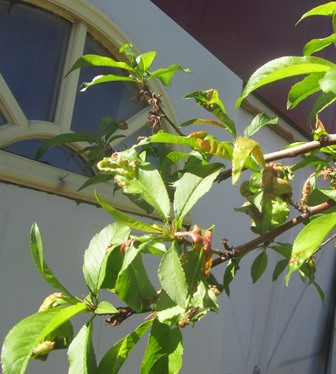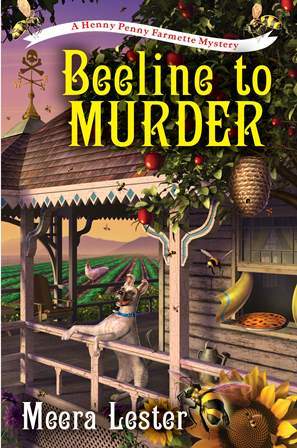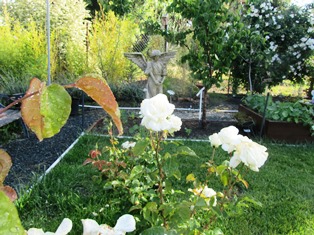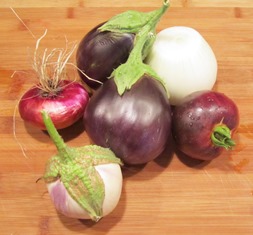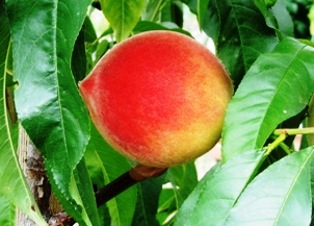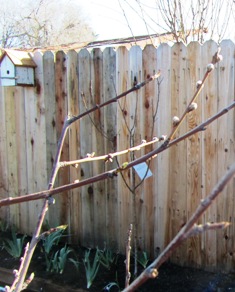The Challenge of Dealing with Peach Leaf Curl
The rains have turned Northern California hills and fields green with wild grasses and weeds. On my farmette, the fruit trees are blooming and the peaches have leafed out. The dreaded peach leaf curl is apparent on many leaves of my peach and nectarine trees.
The peach leaf curl disease is caused by a fungus, Taphrina deformans, according the integrated pest management information posted on the U.C. Davis site: http://www.ipm.ucdavis.edu/PMG/PESTNOTES/pn7426.html. This fungal infection can involve virtually every part of the tree, especially the new leaves, young twigs, new shoots, and fruits. It winters over, too, ready to infect the new growth in the spring.
Picking off the affected leaves and disposing of them in a garbage bag (never in the compost pile) seems intuitive as new the tree will produce new leaves. However, until it does, the tree is exposed to sunburn.
Many expert gardeners say the most effective treatment is prune in the fall to remove any affected branches and twigs. Spray the tree with a fixed copper fungicide after the leaves have fallen in November.
If the winter rains are heavy, you may need another round of spraying in the spring before the blossoms open. Failure to control this fungus can result in the decline of the of quality fruit and ultimately the death of the tree.
Copper fungicide, like any pesticide, is a poison. If you decide to use it, follow the directions on the packaging. Do not spray on a windy day or where the possibility of the spray can drift and contaminate areas where vegetables are ready to be picked.
Organic approaches are less effective but include the following:
1. Keep the plant healthy, but don’t over-fertilize it because that produces more tissue for potential infection.
2. Use good hygiene on and around the tree. Remove diseased leaves, twigs, and fallen leaves and discard (not in the compost pile).
3. Consider replacing the susceptible tree with a peach tree that is more resistant to peach leaf curl such as Redhaven or cultivars of Redhaven.
4. If you defoliate the tree, allow it to re-foliate in warm, dry weather when re-infection is less of a problem. Also thin the fruit crop in a season when there is a particularly severe infection because that will help keep the plant vigorous.
For more tips for farming, gardening, keeping bees and chickens, check out my Henny Penny Farmette series of cozy mysteries. Each chapter features almanac sayings and ends with farming tips or delicious recipes. The books are available through Amazon.com, Barnesandnoble.com, as well as other online and conventional bookstores everywhere.
Fall Spraying for Peach Leaf Curl
Just beyond the sliding glass door of my kitchen, we’ve carved a bit of a lawn and garden out of a wild weedy field. When I’m washing dishes or making jam, I can see my garden sanctuary where I’ve moved in a statue of an angel and positioned a bench near two nectarine trees–a perfect place to sit and take in the view of Mount Diablo’s peaks.
Of late, though the nectarine trees look less than healthy. The two heavy-bearers have become infected with the fungus that causes peach leaf curl. It’s not just my trees that are infected; two of my neighbors have the same problem. And this showed up late in my trees this year.
I’ve tried plucking off the twisted and contorted leaves as they show, discarding them in the garbage (not the compost pile). However, I fear I am losing this battle. The trees are going through a leaf drop now that it’s middle of November. I don’t want that fungus overwintering in the infected leaves, so I’m gathering those into the garbage, too. And I’ll begin a spraying program.
The nectarines and peaches need to be sprayed three or four times (if we have a strong rainy season), from autumn to bud break in the spring. Both lime sulfur and copper sprays can be used; both are considered organic, although some formulations are not very strong. But the leaves must not remain on the ground under the trees.
Last year, I sprayed those trees the required number of times with an organic horticultural oil recommended by the local garden center. The trees were fine most of the summer. But last month, the infection showed up. And here I am now, plucking the leaves from the trees and picking them up from the ground.
I dare not use anything on treating the fungus that is not organic and safe for the honeybees. Come spring, perhaps I’ll be rewarded for my vigilance with new growth that is healthy and free of the fungus.
Could the Weird Weather Be Affecting Our Crops?
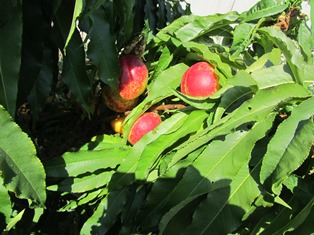
Nectarines are ripening but the tree recently developed peach leaf curl, noticeable in the top right leaves
Since the beginning of the agrarian age, farmers have understood that weather affects crops. To say the weather this year–at least in Northern California–has been weird is an understatement. I can’t help thinking it’s impacting my garden.
In the last three weeks, my healthy nectarine trees developed that dreaded fungal peach leaf curl, despite the prescribe spraying throughout the dormant season with horticultural oil. I’ve got tomato vines spreading everywhere with few tomatoes. The corn developed such a terrible infestation of corn aphids that I pulled out all the corn and fed it to the chickens.
I’m not blaming the weather for my all garden woes, but it’s got to be a factor in what my neighbors and I are witnessing in our gardens and orchards with regard to less bountiful crops.
We have to water because the soil is so dry it’s cracking open. We have to stay on top of pest infestations as we all grow organic and the bees travel through all of our backyards and up to five miles or so. We share our produce and stories of what’s happening in our gardens so we can deal with the problems.
We had very little rain during our rainy season and now local reservoirs are low. For the last three days, the Bay Area has had over 11,000 dry lightning strikes (putting fire departments on high alert), temperatures inching toward triple digits, and high particulate in the air because of all the wildfires burning in our state and elsewhere in the West.
I heard a recent newscaster using that dreaded word “drought” and lamenting about the low level of water currently available for farmers to use for their crops and orchards, especially in the California’s Central Valley, an area considered an important “bread basket” of the United States. The good news is that those farmers will be winding down their water usage as fall approaches and crops are harvested.
As the weather goes, so do the crops–something farmers and gardeners have always understood. My garden woes likely have a lot to do with the head gardener–that’s me. But I’ve been gardening here for four years and this year’s garden has been the least bountiful. While there are many factors to evaluate, the weird weather has to be considered.
Growing Palate-Pleasing Peaches
In the orchard area of the Henny Penny Farmette, we’ve planted several fruiting peach trees. Today, during this first full week in February, the Desert Gold peach trees (Prunus persica) broke into bloom.
These trees are more tolerant of heat than some of the varieties, but if planted in the desert Southwest or even in the hot interior valleys of California, the peach trees will perform better if given a little afternoon shade.
There are basically four types of peach trees: fruiting, flowering, combination fruiting and flowering, and dwarf. All peaches require heat during the hot weather months of their growing cycle and won’t properly set many blooms or be well pollinated during springs that are cold and wet. These trees also need some chilling during the winter months when they drop their leaves and go dormant.
We’ve discovered that our peach trees benefit from regular feedings (I’ve used fish emulsion tea, manure tea, and even chicken manure worked into the soil around the base of the tree) two or three times a year. For mature trees, plan on cutting away 2/3 of the previous year’s growth or cut each branch back about 1/3 it’s total length.
The Internet has some great videos that demonstrate how to properly prune your peach trees.
If you’ve prune your peach tree properly, you’ll have lovely, large fruits. Another technique to increase fruit size is to thin the number of fruits on the tree. Taking away some of the smaller fruits and reducing the size of the crop means that the remaining fruit can enlarge before ripening.
Peach leaf curl, peach leaf borer, and scale insects are pesky problems for peach growers and gardeners. Treatment requires spraying with Bordeaux mixture or lime sulfur twice a year. Nurseries suggests you spray your peach trees in November and again just before the buds swell.
Now, our trees are ready to flower, be pollinated by the honeybees, and produce some luscious peaches by the end of May. I’ll use the ripe peaches to make some palate-pleasing jams.
 Facebook
Facebook Goodreads
Goodreads LinkedIn
LinkedIn Meera Lester
Meera Lester Twitter
Twitter



